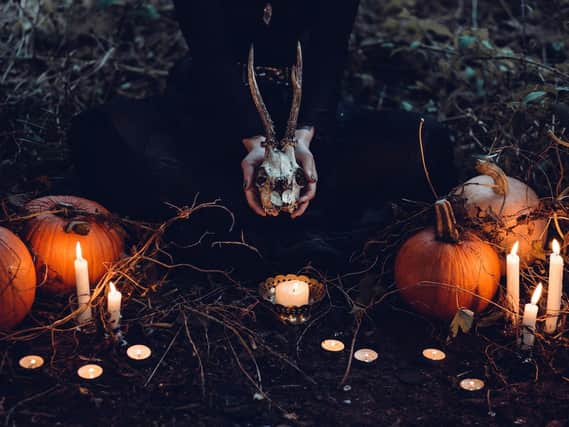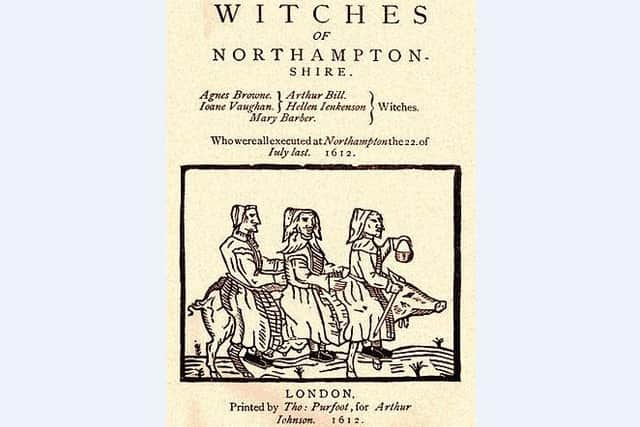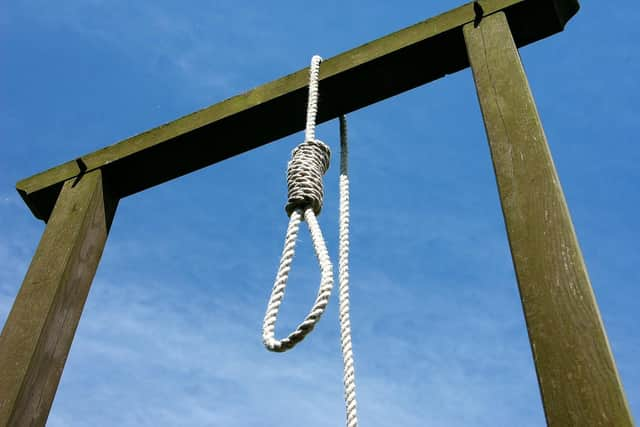The Northamptonshire Witch Trials: The terrible tales of five people who were hanged on the same day for witchcraft in 1612


Witch hunts, described as ‘holocausts of their time’, took Europe by storm from 1450 to 1750 and resulted in the trial of around 100,000 people - just under half of whom were sentenced to death in a number of brutal ways.
The most prominent royal witch-hunter was King James VI of Scotland, who became James I of England in 1603. The execution of his mother - Mary, Queen of Scots - was said to have sparked his dark obsession with magic because he believed that her death was visible to those ‘whose power of sight presented to them a bloody head dancing in the air’.
Advertisement
Hide AdAdvertisement
Hide AdAfter James I’s accession to the throne in England following the death of Elizabeth I in 1603, he ordered that the Elizabethan statute on witchcraft be made more severe. Instead of alleged witches only being punished if their witchcraft caused harm to others, they would be punished just for practicing any form of magic.


If the accused bore the ‘Devil’s Mark’ on their body - a mole or a teat-like mark believed to have been made when the Devil sucked on a part of the witch’s body to seal their pact with Satan - that was sufficient enough for a death sentence.
The Northamptonshire Witch Trials took place in the same year as the notorious Pendle witch trials, which took place in Lancashire in 1612.
Five witches in Northamptonshire - consisting of both men and women - were hanged at Abington Gallows in Northampton on July 22 1612.
Advertisement
Hide AdAdvertisement
Hide AdTwo of these suspected witches were Agnes Brown and her daughter Joan Vaughn, who resided in Guilsborough. They were poor and uneducated and they were viewed as ill-natured and without grace by their neighbours.


Disaster struck after Joan encountered a gentlewoman, mistress Elizabeth Belcher. The gentlewoman claimed she was rude so struck Joan, who vowed to get her revenge for the injury.
Belcher soon fell seriously ill and became bedbound. Her friends blamed Joan then, shortly afterwards, Belcher was crying out that her sickness was caused by Joan and Agnes.
Belcher’s brother, master William Avery, came to visit his sick sister but claimed that he could not enter the house because ‘some malevolent force held him back’. After several attempts, he gave up and returned home. Shortly afterwards, he also began to suffer from the same affliction as his sister and complained to the authorities.
Advertisement
Hide AdAdvertisement
Hide AdJoan and Agnes were brought to Northampton jail. They were visited by Belcher and Avery, who believed that if they scratched the woman and drew blood, they would be cured. They blooded the women and were momentarily ‘cured’, however, as soon as they were out of sight of the women, their fits returned more violently.
Belcher and Avery - on their way home in their coach - passed two strangers riding together on a black horse. The strangers reportedly called out a curse that either Belcher and Avery or their horses should presently have an accident. The coach horses instantly fell dead.
Joan and Agnes were charged with bewitching Belcher and Avery and also of bewitching a child to death. They pleaded not guilty. Testimonies against them claimed that Agnes was sighted with two other ‘witches’, Katherine Gardiner and Joan Lucus, visiting Mother Rhodes, an old witch.
Joan and Agnes were found guilty. Neither were heard praying to God as they awaited their execution. Instead, they cursed those who sealed their fate - this was also taken as proof that they were witches.
Advertisement
Hide AdAdvertisement
Hide AdArthur Bill, from Raunds, was also amongst those five witches executed in Northamptonshire. His parents were both known witches and he was believed by locals to live an evil life and bewitch cattle. In May of 1612, he was accused of bewitching a young woman, Martha Aspines, to death.
Arthur and his parents were apprehended and tested by having their hands and feet bound and then being tossed into deep water. All three floated, which meant that they were guilty of witchcraft. Arthur was promptly arrested on May 29 and jailed.
Arthur and his mother bewitched his father so that he temporarily could not speak out of fear that he would testify against his son. However, he did recover and became the leading witness against Arthur.
Arthur’s mother was scared that she would be hanged for witchcraft so her neighbours urged her to throw herself on God’s mercy. Instead, she cut her own throat, allegedly under the instruction of her familiar - a small animal kept as a witch’s attendant given to her by the Devil or inherited from another witch.
Advertisement
Hide AdAdvertisement
Hide AdBill was charged with several other crimes in addition to murder and maintained his innocence to his last breath. His father’s fate is unknown but his life may have been spared in exchange for testifying against his son.
The fourth witch is Helen Jenkson of Thrapston, who was believed to bewitch cattle. When accused of bewitching a child to death, she was pricked and found to have the ‘Devil’s Mark’ on her body. Mistress Moulsho, who pricked Helen, found her laundry to be covered with images of toads, snakes and other ‘ugly creatures’. She immediately returned to Helen’s home and threatened to scratch her eyes out if her laundry was not returned to its former state. When she got home, the images were gone.
Helen was arrested and imprisoned on May 11 in 1612. She also maintained her innocence during the trial and right up to her death.
The fifth and final witch executed on that fateful day of July 22 1612 was Mary Barber of Stanwick. She was described as having ‘mean parents’ and was ‘monstrous and hideous both in her life and actions’. She was accused of bewitching cattle and bewitching a man to death.
Advertisement
Hide AdAdvertisement
Hide AdMary pleaded not guilty. An account of her trial states only that ‘good evidence’ was presented against her and she was found guilty. She too was executed by hanging.
These cases were derived from ‘Encyclopedia of Witches, Witchcraft and Wicca’ by Rosemary Ellen Guiley.